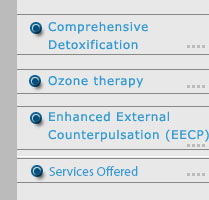






|
Ozone has been used in medicine since the last century because of its Bathing with ozone is an excellent way to help gently detoxify the body. Three ozone baths a week will help to revitalize the body's largest organ: The skin. While water will hold more ozone than air, this type of therapy is not as effective as a sauna therapy, unless a way is devised to completely insulate the the bath to maintain higher levels of ozone concentration. Ozone baths may be taken with ozone at a concentration of between 2% and 5%. studies have shown that when ozone is introduced into the blood in microgram doses, it is immediately converted into hydroperoxides which are free radical scavengers: glutathione, catalase, super oxide dismutase, etc. They have shown remarkable antibacterial and antifungal effects. Infected cells have lower levels of enzyme activity and are less stable. The hydroperoxides readily react with the cell membrane lipids. Through reaction of ozone with the phospholipid chains in the cell membrane, lipoperoxides are introduced into the cell and influence its metabolism; in particular, polyunsaturated fatty acids whose peroxides have a selective cytotoxic effect and have growth inhibiting effects in human lung, breast, and prostate cancer cells. Ozone therapy has been in use for many years by thousands of West German doctors who have proven in hundreds of clinical studies that they are able to inactivate AIDS/CANCER and other viruses through the use of ozone.
According to Frank Shallenberger, M.D. author of The Principles and Applications of Ozone Therapy , oxygen therapies affect the human body in the following ways: 1. They stimulate the production of white blood cells , which are necessary to fight infection. 2. Ozone and hydrogen peroxide are virucidal. 3. They increase oxygen and hemoglobin disassociation, thus increasing the delivery of oxygen from the blood to the cells. 4. Ozone and hydrogen peroxide are anti-neoplastic, which means that they inhibit the growth of new tissues such as tumors. 5. They oxidize and degrade petrochemicals. 6. They increase red blood cell membrane flexibility and effectiveness. 7. Oxygen therapies increase the production of interferon and Tumor Necrosis Factor, which the body uses to fight infections and cancers. 8. They increase the efficiency of the anti-oxidant enzyme system, which scavenges excess free radicals in the body. 9. They accelerate the citric acid cycle, which is the main cycle for the liberation of energy from sugars. This then stimulates basic metabolism . 10. Oxygen therapies increase tissue oxygenation, thus bringing about patient improvement. The ultimate effects of Bio-Oxidative therapies at the cellular level are: · Increase metabolic efficiency of all cells · Stimulate cellular immunity (protects against infections) and suppress humoral immunity (allergic reactions) · Regulate cytokines, which control the action of all immune system cells · Regulate hormone production · Increase energy production · Direct killing effect of bacteria, viruses, and yeast cells · Stimulate the production of more natural antioxidant enzymes · Detoxification of chemicals, pesticides, and other volatile toxins There are several disease categories that can be very amenable to treatment with bio-oxidative therapies. However, for some patients with significant toxicity issues and severe deficiencies in intracellular vitamins and minerals, oxidative treatments may not be recommended until the body has been adequately cleansed of toxins, especially any heavy metals that may be present. These toxic substances are constant sources of free radicals, and therefore additional oxidizing energy can be counter-productive at this stage. Once toxins are removed and there is a reduction in this ongoing free radical damage, the cells begin to recover and generate natural anti-oxidant enzymes to better protect them in the future from additional free radicals. Some individuals may be recommended to begin oxidative therapies at an earlier stage in their program. Some of the conditions that bio-oxidative therapies have been reported in the scientific literature and by physicians to be of benefit in the following conditions:
Remember how hydrogen peroxide foams up when applied to an open wound? Those foaming bubbles are pure oxygen produced by hydrogen peroxide reacting with a blood enzyme catalase. A small amount of hydrogen peroxide can produce a very large amount of oxygen. Areas of the body suffering oxygen deficiency due to poor circulation benefit greatly from the addition of this extra oxygen. |